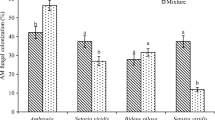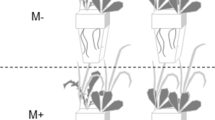Abstract
Recent studies have established the controlling influence of rhizospheric biota, especially arbuscular mycorrhizal fungi (AMF), on colonization and spread of some alien plants in their introduced range. But how AMF from different geographical sources influence traits that contribute to invasiveness, particularly in presence of neighbouring plants of other species, has been rarely investigated. Thus, we compared the influence of some local (Kashmir Himalayan isolates) and non-local (isolates from Rajasthan, India) AMF isolates of Glomus moseae, G. fasciculatum and Gigaspora margarita on vegetative and reproductive attributes of Mayweed Chamomile (Anthemis cotula L.), a highly invasive species in the Kashmir Himalaya, India. We also examined whether or not the neighbouring plant species, namely Daucus carota L. (Apiaceae) alters the mutualistic interaction between the AMF and A. cotula. Pot experiments revealed greater positive impact of the local than the non-local AMF on vegetative as well as reproductive attributes of A. cotula. Experimental field studies showed that the incidence of highly prevalent Arum-type mycorrhizal colonization in natural populations of A. cotula was reduced in presence of D. carota. Besides, the local AMF significantly promoted growth of A. cotula more than D. carota under mixed-culture conditions. These results suggest that the facilitation of some alien plant invasions by AMF needs to be considered together with plant–plant interactions and invasion-induced changes in the soil microbial community.


Similar content being viewed by others
References
Abigail ARK, Hartnett DC, Wilson GWT (2005) Effects of mycorrhizal symbiosis on tallgrass prairie plant–herbivore interactions. Ecol Lett 8:61–69
Allaie RR, Reshi Z, Wafai BA (2005) Demographic studies on alien invasive Anthemis cotula L. in Kashmir Himalaya. Trends Life Sci 20:49–56
Allaie RR, Reshi Z, Rashid I, Wafai BA (2006) Effects of aqueous leaf leachate of Anthemis cotula—alien invasive species on germination behaviour of some field crops. J Agron Crop Sci 192:186–191
Bever JD (1994) Feedback between plants and their soil communities in an old field community. Ecology 75:1965–1977
Bierman B, Linderman RG (1981) Quantifying vesicular arbuscular mycorrhizae: a proposed method towards standardization. New Phytol 87:63–67
Burns JH (2004) A comparison of invasive and non-invasive dayflowers (Commelinaceae) across experimental nutrient and water gradients. Divers Distrib 10:387–397
Callaway RM, Mahall BE, Wicks C, Pankey J, Zabinski C (2003) Soil fungi and the effects of an invasive forb on native versus naturalized grasses: neighbor identity matters. Ecology 84:129–135
Carey EV, Marler MJ, Callaway RM (2004) Mycorrhizae transfer carbon from a native grass to an invasive weed: evidence from stable isotopes and physiology. Plant Ecol 172:133–141
Casper BB, Castelli JP (2007) Evaluating plant–soil feedback together with competition in serpentine grassland. Ecol Lett 10:394–400
Eom AH, Hartnett DC, Wilson GWT (2000) Host plant species effects on arbuscular mycorrhizal fungal communities in tallgrass prairie. Oecologia 122:435–444
Erneberg M (1999) Effects of herbivory and competition on an introduced plant in decline. Oecologia 118:203–209
Fumanal B, Plenchette C, Chauvel B, Bretagnolle F (2006) Which role can arbuscular mycorrhizal fungi play in the facilitation of Ambrosia artemisiifolia L. invasion in France. Mycorrhiza 17:25–35
Hallett SG (2006) Dislocation from coevolved relationships: a unifying theory for plant invasion and naturalization. Weed Sci 54:282–290
Hawkes CV, Belnap J, D’Antonio C, Firestone MK (2006) Arbuscular mycorrhizal assemblages in native plant roots change in the presence of invasive exotic grasses. Plant Soil 281:369–380
Kay QON (1971) Anthemis cotula L. series: biological flora of the British Isles. J Ecol 59:623–636
Marler MJ, Zabinski CA, Callaway RM (1999) Mycorrhizae indirectly enhances competitive effects of invasive forbs on a native bunch grass. Ecology 80:1180–1186
McGonigle TP, Miller MH, Evans DG, Fairchild GL, Swan JA (1990) A new method which gives an objective measure of colonization of roots by vesicular–arbuscular mycorrhizal fungi. New Phytol 115:495–501
Mummey DL, Rillig MC (2006) The invasive plant species Centaurea maculosa alters arbuscular mycorrhizal fungal communities in the field. Plant Soil 288:81–90
Mummey DL, Rillig MC, Holben WE (2005) Neighbouring plant influences an arbuscular mycorrhizal fungal community composition as assessed by T-RFLP analysis. Plant Soil 271:83–90
Perrings C, Dehnen-Schmutz K, Touza J, Williamson M (2005) How to manage biological invasions under globalization. Trends Ecol Evol 20:212–215
Phillips SJM, Hayman DS (1970) Improved procedures for clearing roots and staining parasitic and vesicular–arbuscular mycorrhizal fungi for rapid assessment of infection. Trans Br Mycol Soc 55:158–160
Pimentel D, Zuniga R, Morrison D (2005) Update on the environmental and economic costs associated with alien-invasive species in the United States. Ecol Econ 52:273–288
Rashid I, Reshi Z, Shah MA, Wafai BA (2006) Does herbivory promote invasiveness of Anthemis cotula in Kashmir Himalaya, India? In: International Symposium on Biology, Ecology and Management of world’s worst plant invasive species 10–14 Dec. CEMDE, University of Delhi, India
Rashid I, Reshi Z, Wafai BA (2007) Germination ecology of invasive alien Anthemis cotula L. helps it synchronize its successful recruitment with favourable habitat conditions. Ann Appl Biol 150:361–369
Read DJ, Koucheki HK, Hodgson J (1976) Vesicular arbuscular mycorrhiza in natural vegetation systems. I. The occurrence of infection. New Phytol 77:641–653
Reeves FB, Wagner D, Moorman T, Kiel J (1979) The role of endomycorrhizae in revegetation practices in the semi-arid west. I. A comparison of incidence of mycorrhizae in severely disturbed vs. natural environments.. Am J Bot 66:6–13
Reinhart KO, Callaway RM (2006) Soil biota and invasive plants. New Phytol 170:445–457
Ruiz-Lozano JM, Azcón R, Gomez M (1995) Effects of arbuscular–mycorrhizal Glomus species on drought tolerance: physiological and nutritional plant responses. Appl Environ Microbiol 61:456–460
Schenck NC, Perez Y (1990) Manual for the identification of VA mycorrhizal fungi. Synergistic, Gainesville
Scheublin TR, Van Logtestijn RSP, Van’ der Heijden MGA (2007) Presence and identity of arbuscular mycorrhizal fungi influence competitive interactions between plant species. J Ecol 95:631–638
Shah MA, Reshi Z (2007) Invasion by alien Anthemis cotula L. in a biodiversity hotspot: release from native foes or relief from alien friends. Curr Sci 92:21–22
Shah MA, Reshi Z, Rashid I, Wafai BA (2006) Effect of native and non-native arbuscular mycorrhizas on seedling establishment and competitive interactions of A. cotula in Kashmir Himalaya. In: International Symposium on Biology, Ecology and Management of World’s Worst Plant Invasive Species, 10–14 Dec. CEMDE, University of Delhi, India
Simberloff DS, von Holle B (1999) Positive interactions of nonindigenous species: invasional meltdown. Biol Inv 1:21–32
Stampe ED, Daehler CC (2003) Mycorrhizal species identity affects plant community structure and invasion: a microcosm study. Oikos 100:362–372
Stinson KA, Campbell SA, Powell JR, Wolfe BE, Callaway RM, Thelen GC et al (2006) Invasive plant suppresses the growth of native tree seedlings by disrupting belowground mutualisms. PLoS Biol 4:1–5
Streitwolf-Engel R, Boller T, Weimken A, Sanders IR (1997) Clonal growth traits of two Prunella species are determined by co-occurring arbuscular mycorrhizal fungi from a calcareous grassland. J Ecol 85:181–191
Van’der Heijden MGA (2002) Arbuscular mycorrhizal fungi as determinant of plant diversity: in search of underlying mechanisms and general principles. Ecol Stud 157:243–266
Zabinski CA, Quinn L, Callaway RM (2002) Phosphorus uptake, not carbon transfer, explains arbuscular mycorrhizal enhancement of Centaurea maculosa in the presence of native grassland species. Funct Ecol 16:758–765
Acknowledgements
We thank Stefano Benvenuti, ARI, University of Pisa, Italy, for providing information about A. cotula in its native range and C.C. Daehler, University of Hawaii, Manoa, USA, Ian Baldwin, Max Planck Institute, Germany, and R. Callaway, University of Montana, USA, for their suggestions and critical appraisal of the earlier draft of this manuscript and providing useful suggestions. First author thanks the International Foundation of Sciences (IFS) Sweden for sponsoring his visit to Montpllier, France to attend and present this paper in the international conference Rhizosphere 2. The authors are indebted to two anonymous reviewers for their valuable suggestions that helped considerably to improve quality of the manuscript.
Author information
Authors and Affiliations
Corresponding author
Additional information
Responsible Editor: Tim Simon George.
Rights and permissions
About this article
Cite this article
Shah, M.A., Reshi, Z. & Rashid, I. Mycorrhizosphere mediated Mayweed Chamomile invasion in the Kashmir Himalaya, India. Plant Soil 312, 219–225 (2008). https://doi.org/10.1007/s11104-008-9706-1
Received:
Accepted:
Published:
Issue Date:
DOI: https://doi.org/10.1007/s11104-008-9706-1




